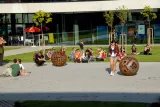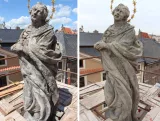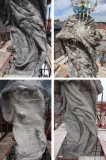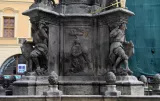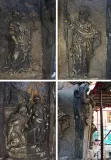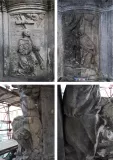- Carried out in: 2015-2019
- Location: Kutná Hora
- Origin: the 17th century
- Material: Kutná Hora limestone
- Executed by students: Roman Kolář, Kateřina Šibravová, Radka Zůfalá, Peter Majoroš, Viktor Gallistl, Zuzana Auská, Jiří Škarvada, Klára Teturová, Jakub Balcar, Rudolf Trucla, Marek Knot, Karolína Ludvová
- Teaching supervision by: doc. Jakub Ďoubal Ph.D., MgA. Petra Zítková
- Chemical-technology survey by: Ing. Petra Lesniaková, Ph.D.
The Marian plague column in Kutná Hora was erected between 1713-14 by František Baugute. The conservation treatment of the plague column made of Kutná Hora limestone began in 2015 by conserving a selected sample area. Altogether, there were four phases of the conservation process which encompassed the conservation treatments of the sculpture of the Virgin Mary at the top of the column, continued in the conservation works of the pyramidal pylon adorned with clouds, the middle and bottom plinths with reliefs, sculptures of patron saints and miners and, finally, by the treatment of the balustrade and the stairs. The conservation of the whole Marian plague column was completed in 2019. It was conserved by the students of different years of their studies as part of their final graduation projects.
Among the most critical issues that we had to deal with during the conservation works was the in-depth damage of the material caused by degradation of limestone due to acid rain, inappropriate repairs of the past conservation treatments (consolidation with epoxide, hard cement repairs, application of dispersion to unify the surface all over its area) and soiling of the surface with biological growth and gypsum crusts. The cleaning was carried out with the use of regulated steam, the dark gypsum crusts were removed by a very gentle method using Q-switched ND:YAG laser. Desalination was executed employing the application of cellulose poultices. It was also necessary to take off the inappropriate hard fillings with a diamond micro miller. One of the most crucial moments was the in-depth consolidation with the use of infusion. The depth of penetration and effectiveness of consolidation was measured by resistance drilling and ultrasound transmission measurement. It was the in-depth consolidation and its subsequent assessment using state-of-the-art instrumental methods that allowed sufficient securing of the eroded material. A hydraulic-lime-based mixture containing suitable aggregate was used for filling. The final composition of the mixture suitable for the particular type of stone was a result of a long-term series of tests performed at the Faculty of Restoration.
